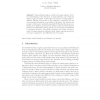Free Online Productivity Tools
i2Speak
i2Symbol
i2OCR
iTex2Img
iWeb2Print
iWeb2Shot
i2Type
iPdf2Split
iPdf2Merge
i2Bopomofo
i2Arabic
i2Style
i2Image
i2PDF
iLatex2Rtf
Sci2ools
IWEC
2007
2007
Game Design Guided by Visual Attention
Abstract. Visual attention plays a critical role in game playing. A better understanding of the allocation of visual attention can benefit the design of game scenarios. In this paper we propose to design games in different difficulty levels based on the estimation of attention. We use eye movement information in an analysis of attention. Eye fixation and pursuit conditions are considered separately.We find that the image complexity at eye fixation points and the relative position between pursuit direction and disturbance during pursuit eye movements are significant for attention allocation. This result is applied to the design of an interactive 2D game having two difficulty levels. Player response speeds and scores are compared for each difficulty level of the game. game design, visual attention, eye fixation, eye pursuit
Related Content
| Added | 30 Oct 2010 |
| Updated | 30 Oct 2010 |
| Type | Conference |
| Year | 2007 |
| Where | IWEC |
| Authors | Li Jie, James J. Clark |
Comments (0)

